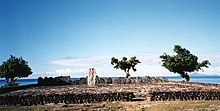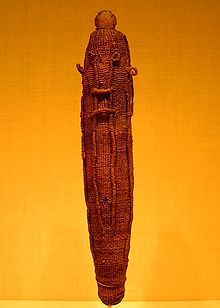Oro (god)
Oro is a deity of the Polynesian pantheon . The worship of Oro, although not practiced with equal intensity on all islands, was an important cult of the Society Islands of the 17th and 18th centuries, particularly Tahiti and Raiatea . In Tahiti, Oro was the main deity and the god of war. The Arioi secret society was closely linked to his rites. In the Marquesas he was called Mahui.
origin
The colonization of the Polynesian Triangle took place, starting from the Lapita culture , probably from the 12th century BC. In several waves to the east, into the Pacific Ocean. With the colonization of the islands, the colonists also spread their religion . In the course of the centuries of continued development of the tribal societies, however, there were more or less extensive, local changes and adaptations of the cults on the various islands. Although the cults of the Pacific islands or archipelagos show a common origin, the details can vary considerably.
Four main deities were worshiped on the Polynesian Islands, including the Society Islands: Ta'aroa (originally the god of the sea and fishing), Tane (the god of the forest and craftsmanship), Tu (the ancient god of war) and Ro´ o (god of agricultural products and weather).
On the island of Raiatea the priests raised the god Ta'aroa from the god of the sea - already an important function for a seafaring people - to the creator of the world. This could be related to the fact that the Ariki, the chiefs and members of the highest nobility, traced their descent directly to Ta'aroa. With the exaltation of their god and ancestor, they exalted themselves at the same time. A consistent further development of this cult was the veneration of Oro, the son of Ta'aroa and Hina-tu-a-uta (Hina). The cult of Ta'aroa also spread to some of the Cook Islands , the Tuamotu Archipelago and Mangareva . The large archipelagos New Zealand and Hawaii remained untouched by this development, there Ta'aroa retained his original position as god of the sea. Logically, Oro did not have the outstanding position on other islands in the South Pacific as it did on Tahiti and Raiatea.
The mythical birthplace of Oro is the Marae Taputapuatea in the Opoa Valley on the island of Raiatea. With the increasing influence of this place of worship - Taputapuatea can be described as a kind of central pilgrimage site in Polynesia - on religious and political power, the rank of Oro in the Polynesian pantheon also increased. On the neighboring island of Tahiti, the worship of Oro became increasingly important in the late proto-historical or early historical period, a first step from polytheism to monotheism . According to legend, a wise woman from Raiatea with the nickname "The Brave" founded a school in Tahiti to spread the teachings of Oro on the large neighboring island.
The Oro cult was significantly promoted by the influential secret society of the Arioi, which was of both religious and significant power-political importance. The highest nobility and priestly ranks belonged to him. The Arioi traced the founding of their order directly back to Oro.
→ Main article: Arioi
In Tahiti, Oro was the god of war, who changed himself to the god of the fine arts in peacetime as "Oro who lays down the spear". Pigs were usually sacrificed to him, but people were also sacrificed during important rites. James Cook witnessed such a human sacrifice on his third voyage in 1777 . The prisoner was held on a platform by assistants while a priest smashed his skull with a consecrated club.
Legend
According to legend, Oro lived with his sisters Teouri and Oaaoa on Mount Pahia on the island of Bora Bora . He asked his sisters to help them find a suitable wife. Oro descended on a rainbow in the form of a young warrior. His search on various islands was initially in vain, which made his sisters sad. On their return to their home on the Pahia, the sisters reached the village of Vaitape on Bora Bora. There they saw a beautiful young woman named Vairaumati bathing in a pond. They told Oro about their meeting and he decided to make Vairaumati his wife. Vairaumati also took a liking to the young, strong warrior. Oro descended to earth every morning to meet Vairaumati and returned to Pahia in the evening. After a while she gave birth to a son who became a powerful chief. Oro went up in the form of a flame and raised Vairaumati to be a goddess.
The rainbow motif can also be found in the mythology of Hawaii, although the cult of Oros is a late creation that can be set long after the settlement of the Hawaiian archipelago, starting from the Society Islands. In Hawaii, the god Lono descended to earth on a rainbow. The motif of the marriage of a human woman to a god descending from heaven is a fundamental theme of Polynesian mythology, but is also found in numerous other myths of humanity.
Manifestations
The Polynesian gods manifested themselves in two different ways: as Ata and As To'o .
Ata, was an object of nature chosen by man to symbolize the incarnation of God. With Oro as
- Oro-i-te-maro-tea: (Oro from the yellow belt), the manifestation of Oro as a light yellow thrush.
- Oro-i-te-maro-ura: (Oro from the red belt) the manifestation of Oro as a red-green A'a bird.
To'o was a man-made object, for example a wooden or stone figure that was supposed to imitate the appearance of the god. In Tahiti, for the god Oro, this was an image wrapped in coconut fiber with a wooden “soul” in the middle, shaped like a club. Signs of the god red or yellow feathers were tied into the coils. The to'o were kept on the ceremonial platforms and regularly dressed with tapa bark fiber in a complicated ceremony . This ritual was possibly related to the funeral cult, in which the corpse was wrapped in tapa and exposed.
swell
- ↑ Jacques Antoine Moerenhout : Voyages aux îles du Grand Océan. Arthus-Bertrand, Paris 1837, Vol. 1, p. 484 ( online ); English translation: Travels to the Islands of the Pacific Ocean , Lanham, London 1983, p. 244.
- ^ Peter Buck : Vikings of the Sunrise , New York 1938, p. 89 f. ( Online text NZETC )
- ↑ a b Roslyn Poignant: Oceanic Mythology. Vollmer, Wiesbaden 1965
- ↑ James Cook: Entdeckungsfahrten im Pazific, log books of journeys 1768 - 1779. German edition Tübingen / Basel, 1971.
- ↑ Martha Warren Beckwith : Hawaiian mythology. With a new introd. by Katharine Luomala . University of Hawaii Press, Honolulu 1970, ISBN 0-87022-062-4 . (First edition: 1940). ( Online text on www.sacred-texts.com ).
- ^ Robert D. Craig: Dictionary of Polynesian Mythology. Greenwood Press, New York NY et al. 1989, pp. 193-194 , here p. 194 , ISBN 0-313-25890-2 .
- ^ Anthony JP Meyer: Oceanic Art. Oceanic Art. Könemann, Cologne 1995, vol. 2, p. 515, ISBN 3-89508-080-2 .

